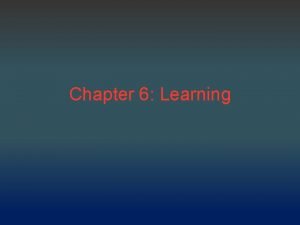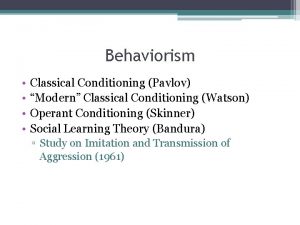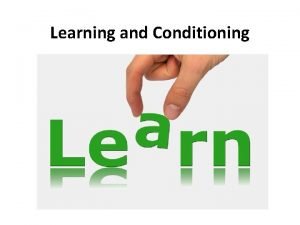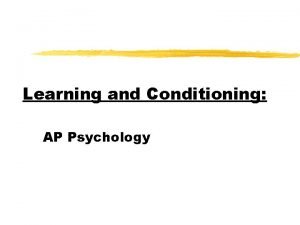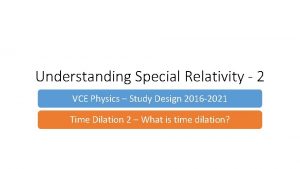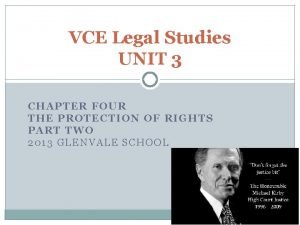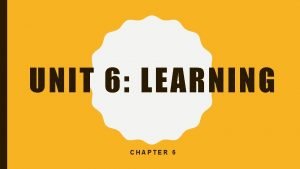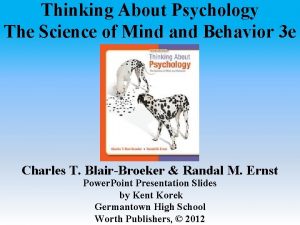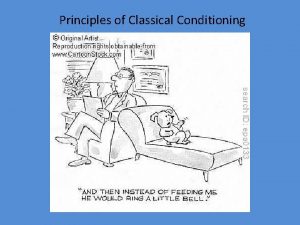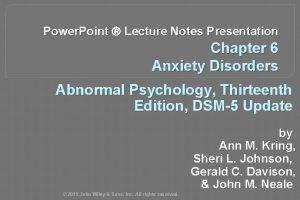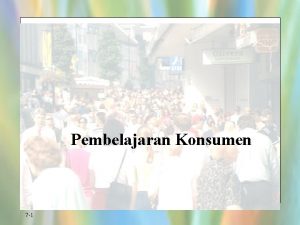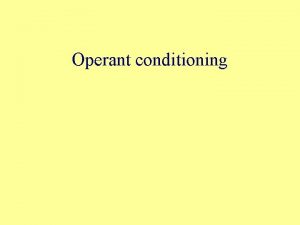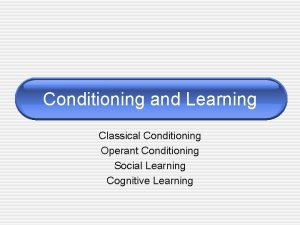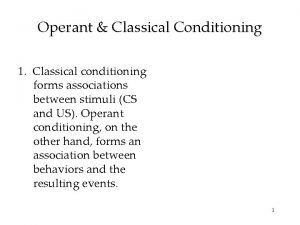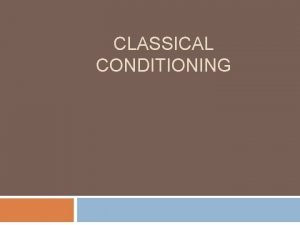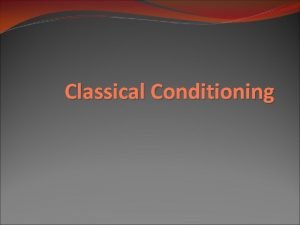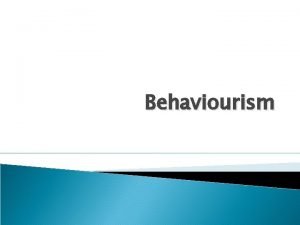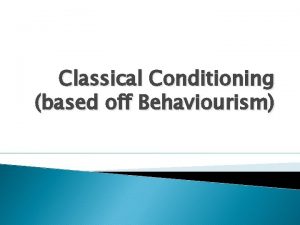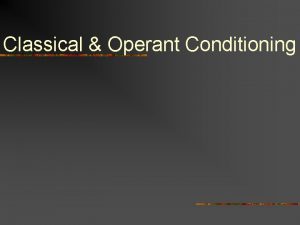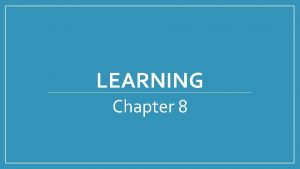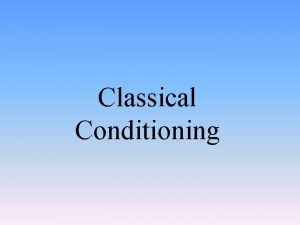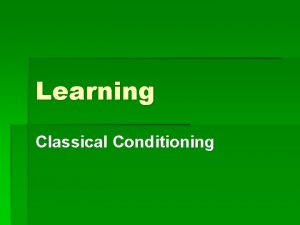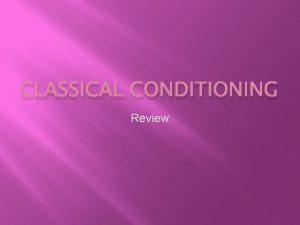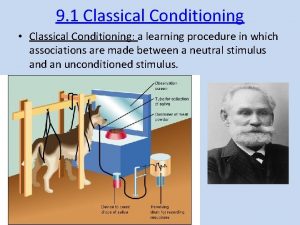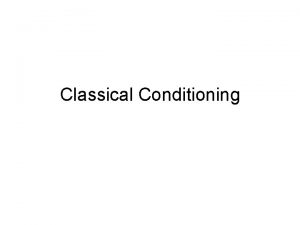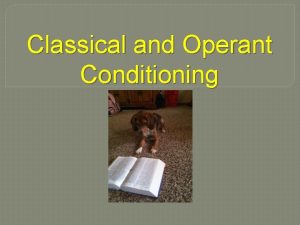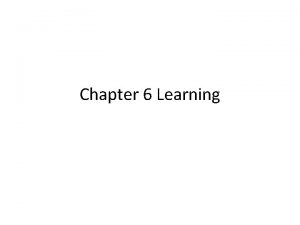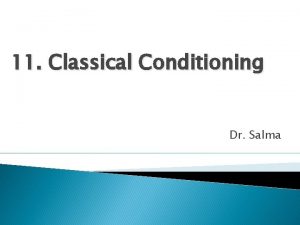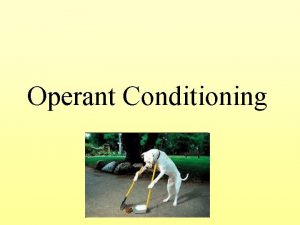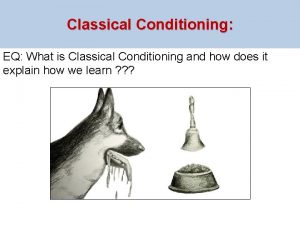VCE PSYCHOLOGY WHAT IS CLASSICAL CONDITIONING Study design





























- Slides: 29

VCE PSYCHOLOGY WHAT IS CLASSICAL CONDITIONING? Study design dot point • Classical conditioning as a three-phase process (before conditioning, during conditioning and after conditioning) that results in the involuntary association between a neutral stimulus and unconditioned stimulus to produce a conditioned response, including stimulus generalisation, stimulus discrimination, extinction and spontaneous recovery

© Kristy Kendall & Edrolo 2017

Models to explain learning • Learning is commonly defined as a relatively permanent change in behaviour that occurs as a result of experience. It is an ongoing process that continues throughout the lifespan, enabling us to adapt and cope in an ever-changing world. • One of the most basic learning processes involves linking two events that occur close together. Conditioning is the process of learning associations between a stimulus in the environment (one event) and a behavioral response (another event). • A conditioned response is any type of learned response. Similarly, anything can be a stimulus, as long as our senses can detect it. For example, it can be a phone, light, insect or house, a sound, an odor, a puff of air, a touch, a change in temperature, an event we see happening or an event we read or hear about. • The two main types of conditioning on which psychologists have tended to focus are classical conditioning and operant conditioning.

What is Classical Conditioning? • You start to feel anxious when you walk through the entrance of a hospital, even though you are only going to visit an aunt who has a new baby. • You are driving with your P-plates, when you hear a siren and see flashing lights behind you. You get a sinking feeling in your stomach but then realize, with relief, that it’s a re engine and not the police, so you pull over to let them through. • Your dog salivates when he hears the microwave ‘ping’. All of these behaviors have been learned through a simple process known as classical conditioning. • A simple form of learning, which occurs through repeated association of two different stimuli to produce a naturally occurring response. • Also referred to as respondent conditioning or Pavlovian conditioning. • In classical conditioning the learner is passive. Learning occurs involuntarily

Pavlov’s research • Classical conditioning was first described in the early twentieth century. Ivan Pavlov, who had won the Nobel Prize for physiology in 1904, was continuing his research on the digestive system of dogs when he noted that the dogs salivated before they received food. • Pavlov hypothesized that the dogs had come to associate the footsteps of the laboratory technician who fed the dogs with the presence of the food that was given to them, and that this sound had been conditioned to cause the reflex response of salivation. • In Pavlov’s experiment, the stimulus of food initially produced the response of salivation. Eventually however, the sight or sound of the technician became the stimulus that produced the salivation response • Salivation had become associated with, and conditioned to, a new stimulus — the sight or sound of the technician. This new stimulus was originally a ‘neutral’ stimulus because it did not produce any specific response before he was associated with food. • The process through which the dog learned to associate the sight or sound of the technician with food is basically the process of classical conditioning • Classical conditioning refers to a type of learning that occurs through the repeated association of two (or more) different stimuli. Learning is only said to have occurred when a particular stimulus consistently produces a response that it did not previously produce.

• To minimize the influence of potential confounding variables, the dog was restrained in a harness that held it in the desired position. Food (meat powder) was placed directly on the dog’s tongue or in its bowl. A tube was surgically attached to the dog’s cheek near one of the salivary glands. This drained saliva straight out into a type of test tube that enabled precise measurements of the amount of saliva secreted.

• Learning results from the involuntary linking of this stimulus, over a number of trials, with a stimulus that normally produces the response automatically. • In classical conditioning, a response that is automatically produced by one stimulus becomes associated, or linked, with another stimulus that would not normally produce this response. • In later experiments, Pavlov varied the stimulus that had been conditioned to test whether it would still produce the same response (salivation). He found that the salivation response could be brought on after repeated associations of the meat powder with a range of different stimuli such as a bell, the musical tone of a tuning fork, a light, a tug on the hind leg or even the sight of a circle.

Classical conditioning as a three-phase process • Classical conditioning if often described as a learning process that occurs in a series of three phases or stages — before conditioning, during conditioning and after conditioning. • Five key terms are used to explain the entire process and are applied whenever describing or analyzing any simple response or more complex behavior acquired through classical conditioning. Before Conditioning During Conditioning After Conditioning

Classical conditioning elements (5 key terms) Neutral stimulus Produces no naturally occurring response. Unconditioned stimulus Something that is presented that produces a naturally occurring response (unconditioned response). Unconditioned response A reaction that occurs upon presentation of an unconditioned stimulus. Conditioned stimulus Something that is presented that, when repeatedly paired with an unconditioned stimulus, produces a conditioned response. Conditioned response A reaction that occurs upon presentation of a conditioned stimulus.

Pavlov and the 5 elements • The unconditioned stimulus (UCS) is any stimulus that consistently produces a particular, naturally occurring, automatic response. In Pavlov’s experiments, the UCS was the food. • The unconditioned response (UCR) is the response that occurs automatically when the UCS is presented. A UCR is a reflexive involuntary response that is predictably caused by a UCS. In Pavlov’s experiments, the UCR was the salivation by the dogs to the presence of food. • The neutral stimulus (NS) is any stimulus that does not normally produce a predictable response. In particular, this stimulus is ‘neutral’ to the UCR. For example, dogs do not normally salivate in response to the ringing of a bell. • The conditioned stimulus (CS) is the stimulus that is ‘neutral’ at the start of the conditioning process but eventually triggers a very similar response to that caused by the UCS, so the bell is the NS and CS • The conditioned response (CR) is the learned response that is produced by the CS. The CR occurs after the NS has been associated with the UCS and has become a CS. The behavior involved in a CR is very similar to that of the UCR, but it is triggered by the CS alone. Salivation is the UCR and CR.


Summary of 3 stages PHASE First phase (before conditioning) DESCRIPTION > Involves a response to a stimulus that has not yet been conditioned. It is natural or automatic > This is explained as an unconditioned stimulus (UCS) that results in an unconditioned response (UCR) > During this phase there is also a neutral stimulus (NS) that causes no response Second phase (during conditioning) > Involves the development of an association between the neutral stimulus (NS) and the unconditioned stimulus (UCS) Third phase (after conditioning) > Results in the now conditioned stimulus (CS) producing a conditioned response (CR) as a result of its association with the unconditioned stimulus (UCS) > This causes the neutral stimulus (NS) to become a conditioned stimulus (CS)

• Pavlov’s dogs displayed a CR (salivation) only when they began to salivate to a CS. When a dog responded to a CS such as the sound of a bell, classical conditioning had taken place because salivation would not be a usual response to the sound of a bell. • During classical conditioning, each paired presentation of the NS with the UCS is referred to as a trial. • The term acquisition is used to describe the overall process during which an organism learns to associate two events — the NS and the UCS — until the NS alone has become a CS that produces the CR. • During acquisition, the presentations of the NS and the UCS occur close together in time and always in the same sequence. The duration of the acquisition stage is usually measured by the number of trials it takes for the CR to be acquired (learned). This may vary considerably.

Hints and tips When identifying in scenario work: • The NS and CS are the same • The UCR and CR are the same, but you must write what the response is at • It can be easier to start with the CS and CR (look for. . . now they. . . ) and then work backwards When defining the five terms: Describe them in terms of their role



Stimulus generalization • Once a person or an animal has learned to respond to a conditioned stimulus, other stimuli that are similar to the CS may also trigger the CR, but usually at a reduced level. • For instance, Pavlov observed that his dogs salivated to other noises that sounded like the bell (a tuning fork and a metronome). This is called stimulus generalization. • Stimulus generalization is the transfer of a learned response from one stimulus to another similar stimulus. • In stimulus generalization, the greater the similarity between stimuli, the greater the possibility that a generalization will occur. https: //www. youtube. com/watch? v=1 kq. Vxg. PBIX 0

• Stimulus generalization is evident in various aspects of everyday life. Many kinds of loud noises can make us flinch etc. • While stimulus generalization is rarely an intentional or even a conscious process, it has a valuable adaptive role. • For example a child who burns a finger while playing with matches. A lit match will probably become a conditioned fear stimulus. It is also likely that the child will develop a healthy fear of flames from other potentially harmful sources, such as lighters, fireplaces, stoves etc. • In some situations, stimulus generalisation can be non-adaptive or even harmful. For example, a dog that instinctively snaps at annoying flies may also snap at a wasp, with painful consequences.

Stimulus discrimination • This occurs when a person or animal responds to the CS only, but not to any other stimulus that is similar to the CS. • For example, in a classical conditioning experiment, stimulus discrimination would be observed when a dog salivated only in response to the sound of the ‘experimental’ bell, and not in response to any other similar sound such as a front doorbell, the sound of a telephone ringing or the bell of an ice-cream van. • Stimulus discrimination would be evident in everyday life if someone who has a fear of a particular dog that has frightened them doesn’t flinch at the sight of other breeds of dog. This occurs because the person has learnt to discriminate between the two similar stimuli.

Extinction • Extinction is the gradual decrease in the strength or rate of a CR that occurs when the UCS is no longer presented. Extinction is said to have occurred when a CR no longer occurs following presentation of the CS. • A conditioned stimulus–response association is not necessarily permanent. The strength of the association may fade over time or disappear altogether • For example, Pavlov’s dogs eventually ceased salivating (CR) in response to the bell (CS) presented alone after a number of trials in which the food (UCS) did not follow the sound of the bell

Spontaneous recovery • Spontaneous recovery is the reappearance of a CR when the CS is presented, following a rest period after the CR appears to have been extinguished. • Spontaneous recovery would occur if one of Pavlov’s dogs started salivating again to the sound of a bell after extinction. • Spontaneous recovery does not always occur, and when it does it is often short-lived. Furthermore, the CR tends to be weaker than it was originally (during acquisition). If the extinction procedure is repeated several times, eventually the CR will disappear altogether and spontaneous recovery will not occur


Fast five – Question 1 What sort of response is produced in classical conditioning? © Kristy Kendall & Edrolo 2017

Fast five – Question 2 What is the name of the stimulus that produces no response? © Kristy Kendall & Edrolo 2017

Fast five – Question 3 What needs to happen to the UCS & CS for classical conditioning to take place? © Kristy Kendall & Edrolo 2017

Fast five – Question 3 (Answer) What needs to happen to the UCS & CS for classical conditioning to take place? Answer: Repeated association © Kristy Kendall & Edrolo 2017

Fast five – Question 4 What is a naturally occurring response known as? © Kristy Kendall & Edrolo 2017

Fast five – Question 5 What is a learned response known as? © Kristy Kendall & Edrolo 2017

Multiple choice activity Danny’s older brothers like to pop balloons near him. The sudden loud noise frightens him. Now, every time Danny sees balloons he becomes fearful. He cries and runs away so that he can avoid the balloons. Danny also cries when he sees beach balls. In this scenario, the neutral stimulus and the unconditioned stimulus respectively are A. B. C. D. the loud noise and the balloons and the loud noise. the balloons and the beach balls. the loud noise and the beach balls. © Kristy Kendall & Edrolo 2017 (VCAA 2012 Exam 2 Section A Q 5)
 Neurotransmitters psychology
Neurotransmitters psychology Operant vs. classical conditioning
Operant vs. classical conditioning Vicarious reinforcement
Vicarious reinforcement Classical and operant conditioning.
Classical and operant conditioning. Classical conditioning vs operant
Classical conditioning vs operant Operant vs classical conditioning
Operant vs classical conditioning Classical and operant conditioning.
Classical and operant conditioning. Operant conditioning vs classical conditioning
Operant conditioning vs classical conditioning Classical and operant conditioning
Classical and operant conditioning Classical conditioning vs operant conditioning
Classical conditioning vs operant conditioning Operant conditioning classical conditioning
Operant conditioning classical conditioning Ap psychology learning
Ap psychology learning Outdoor education study design
Outdoor education study design Production area drama
Production area drama Physics study design
Physics study design Chinese second language study design
Chinese second language study design Studio arts assessment criteria 2021
Studio arts assessment criteria 2021 Theatre studies study design
Theatre studies study design Vcaa visual communication
Vcaa visual communication Media codes and conventions
Media codes and conventions Vce legal studies study design
Vce legal studies study design Vcaa hhd
Vcaa hhd Vce physics practical investigation ideas
Vce physics practical investigation ideas Vce psychology
Vce psychology Vce psychology scientific poster
Vce psychology scientific poster Little albert experiment summary
Little albert experiment summary Pavlov's dog experiment
Pavlov's dog experiment Order of classical conditioning
Order of classical conditioning Classical conditioning panic disorder
Classical conditioning panic disorder Contoh iklan classical conditioning
Contoh iklan classical conditioning








